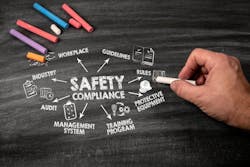How VMS technology is transforming OSHA compliance and workplace safety
Throughout my years as a long-time end user and as a professional within the video security industry, I've witnessed a dramatic shift in how organizations approach workplace safety. What began as passive, after-the-fact video recording systems has evolved into sophisticated platforms that actively contribute to employee safety and OSHA compliance.
Today's open platform video management software (VMS) represents far more than traditional security tools — this technology is a proactive partner in maintaining safer workplaces and ensuring regulatory compliance.
The stakes for workplace safety have never been higher. OSHA violations can result in penalties exceeding $145,000 per incident, not to mention the human cost of workplace injuries, and the potential damage to the company’s reputation. Organizations face mounting pressure to prevent incidents before they occur, yet traditional safety monitoring methods often prove inadequate. This challenge has created an urgent need for more capable safety solutions.
Advancing Workplace Safety Monitoring
Today's work environments present unique challenges for safety managers and compliance officers alike. Manufacturing floors transform rapidly as production needs change, healthcare facilities must maintain constant vigilance over patient and staff safety, while construction sites face ever-changing conditions that can create new hazards daily. Conventional approaches simply can't keep pace with such dynamic environments.
Open platform VMS technology has emerged as a powerful solution to these challenges. By combining high-definition video data with advanced analytic capabilities, these systems can provide unprecedented visibility into workplace conditions. And integration with other building systems extends this capability even further, from automatically detecting wet floors to identifying blocked emergency exits or machinery operating outside normal parameters. This comprehensive approach helps organizations address potential OSHA violations before they result in incidents or citations.
Additionally, advanced analytics can differentiate between normal operations and abnormal behavior patterns, reducing false alarms while ensuring real threats receive immediate attention. For example, an AI-driven system can learn typical patterns of forklift traffic in a warehouse, alerting only when vehicles deviate from safe routes or speeds. In manufacturing, video systems can monitor worker movements around dangerous equipment, automatically warning if safety protocols are breached.
Real-time Hazard Prevention and Response
The ability to prevent accidents before they occur marks a fundamental shift in workplace safety management. Integrated platforms excel at identifying common hazard patterns that often lead to OSHA-reportable incidents. When a potential danger is detected — whether it's a spill in a high-traffic area or equipment operating unsafely — these systems can immediately alert the appropriate personnel.
Consider the challenge of preventing slips, trips, and falls, which constitute a significant portion of workplace injuries. VMS technology can monitor critical areas continuously, using artificial intelligence to detect potential hazards:
- Spills or wet surfaces in walkways
- Objects blocking corridors or emergency routes
- Improper use of safety equipment
- Unauthorized access to restricted areas
- Equipment placed outside designated zones
The detailed video data these systems provide helps safety managers understand root causes and implement corrective measures. Organizations implementing comprehensive video safety solutions often experience significant reductions in workplace incidents within the first year, yielding substantial returns through decreased insurance premiums and avoided OSHA penalties.
In manufacturing environments, video systems can verify proper machine guarding and ensure adherence to safety protocols, while chemical processing facilities use video data to monitor handling procedures and ensure the correct use of personal protective equipment (PPE). Distribution centers use video to oversee lift operations and loading procedures.
According to Occupational Health & Safety Online, organizations implementing these solutions often experience a reduction in incident rates by as much as 30% within the first year, yielding substantial ROI through decreased insurance premiums and avoidance of OSHA penalties.
Beyond Safety to Security Culture
While technology can play a vital role in workplace safety, lasting improvement requires developing a culture where every employee actively participates in maintaining a safe environment. VMS platforms contribute significantly to this cultural shift by providing concrete examples for training and continuous process improvement purposes.
Real-world video examples of both proper safety procedures and near-miss incidents serve as powerful training tools. When employees can see actual situations from their workplace — rather than generic training videos — the impact on behavior and awareness increases dramatically. Organizations using VMS-based training report significantly higher retention of safety procedures and improved compliance with safety protocols.
The National Institute for Occupational Safety and Health (NIOSH) emphasizes the importance of using video and training interventions within mining operations to improve workplace safety. Their research highlights that integrating real-life video examples into training programs can effectively convey the consequences of unsafe practices and the benefits of proper procedures, thereby fostering a stronger safety culture.
The integration of VMS technology also supports broader workplace security initiatives. The same systems that monitor for safety hazards can help prevent workplace violence, ensure proper emergency evacuation procedures, and verify compliance with security protocols. This comprehensive approach creates multiple layers of protection for employees while streamlining compliance efforts across various regulatory requirements.
When employees understand that safety systems are designed to protect rather than police, they become active participants in the safety program. This cultural shift creates a positive feedback loop as employees engage more with safety initiatives, and the effectiveness of the video monitoring system increases, leading to better hazard detection and prevention.
The Future of Workplace Safety
The role of video technology in workplace safety will likely expand further as artificial intelligence and machine learning capabilities advance. These systems will become even more proactive in identifying potential hazards and suggesting preventive measures.
For organizations committed to maintaining the highest safety standards for employees and ensuring OSHA compliance, open platform VMS technology is invaluable in creating and maintaining safer workplaces for all employees. The future of workplace safety isn't just about responding to incidents — it's about preventing them through intelligent, integrated systems that never stop watching for potential hazards.
About the Author

Mark Johnson
Business Development Manager, Cities
Mark Johnson is the National Business Development Manager for Cities at Milestone Systems. Johnson is a highly regarded expert witness in law enforcement technology, use of force and public safety, with extensive experience in state and federal courts. He pioneered independent studies on TASER devices, leading to his role at TASER International (now Axon Enterprise) where he demonstrated their safety and efficacy. As a former law enforcement officer and a co-founder of a body camera company, Johnson has deep insights into policing realities and technological challenges. He collaborates with public safety organizations at all levels to develop tailored safety protocols and optimize operational efficiencies.
